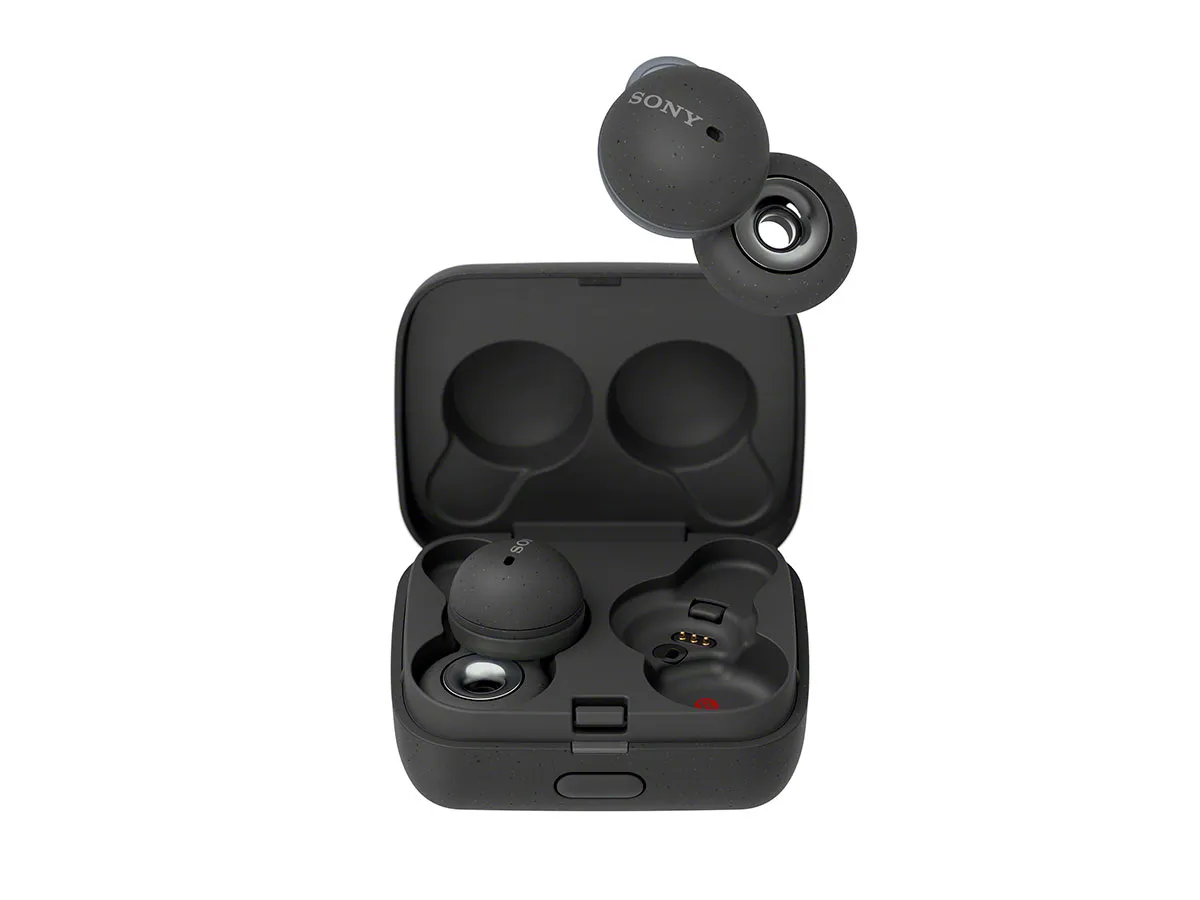For better or for worse, Sony’s LinkBuds stand out clearly as a unique choice in the fiercely over-crowded headphone market. Its circular open design allows you to hear the outside world in clear detail… but also, not escape it at all.
While there are plenty of headphones out there offering transparency modes and ambient sound, none have done it quite to this level and overall, it’s a style that Sony have kind of nailed in their first attempt.
Design

Despite the unique design and host of features Sony has crammed into these earbuds, they are actually very small, and so is the charging case. When tucked away in their little charging home, they are about half the size of the AirPods, Sony’s WF-1000XM4s, and Jabra’s budget Elite 3.
The design of the headphones themselves is what makes Sony’s new venture stand out. Where you would normally have a rubber tip that you insert into your ear, here there is simply a little ring.
This fits into the lower half of your ear, adjacent to the ear canal. As someone who has never been able to get on-board with the fitted rubber tips headphones normally use, I had a great time with the fit of the LinkBuds.
I could put them in easily and know they would stay in whether I was walking, running, working or giving the headphones a good test with a brief but vigorous head-banging session. This is improved further by how light the headphones are, weighing just 4g each (about the weight of four paper clips, if you were wondering).
Sound

The sound quality of the LinkBuds was a surprise. Considering the circular design sitting outside of my ear, I was sure the quality was going to take a major hit, and yet I was often impressed.
It thrived in quiet places like the office or at home but when I was outside, especially in busy areas, the noise of cars, people and the general hustle and bustle would often overpower the sound making it hard to hear - especially with podcasts or quiet audio.
This is both a positive and a negative as I was fully aware of my surroundings at all times, which is the main aim of the LinkBuds.
The headphones feature an open sound stage where certain songs really thrived. This means that instead of audio sounding like it is coming from left and right, it bounces around, seemingly playing from varying directions.
Dire Strait's Money for Nothing feels like it was made for these headphones and the same goes for Queens of the Stone Age's spacey-feeling Better Living Through Chemistry. A live performance of Nothing But Thieves’ Impossible felt like I was sat in the room with them, and Ludovico Einaudi's I Giorni was an equally pleasant experience with the open soundstage the LinkBuds offered.
It's really on the softer side of the music spectrum where these headphones are at their best. The gentle approach of Michael Kiwanuka's KIWANUKAalbum fits perfectly to the open style and the same goes for Alabama Shake's often relaxed blues classic Sound and Colour.

This performance didn't quite translate as well to some heavier tracks. Gojira’s Fortitude album was still hard-hitting but lacked some of its usual bite, and the same for Run the Jewels 4, seriously lacking some bass.
And that is where the sound started to struggle, lacking the harder hits of a bass-heavy track. Even when I took the time to mess with the sound settings found in Sony’s app, bass often felt flat. This mostly comes down to the open design which stops the thumping feel you often get with other headphones that can draw you in to a track.
Features

Despite their size and relatively affordable price tag, the Sony LinkBuds are feature-packed.
These headphones are completely open to the world. Listen to music while hearing cars whizzing past you, people complaining about co-workers and your name called for your coffee order.
While focus is drawn to the 12mm ring-shaped speaker, there is a lot of tech found in the other circular part of the headphones including both the amplifier and the DAC. The LinkBuds use the same powerful processor you’ll find in the immensely popular WF-1000XM4.
One feature that I really wanted to like with the LinkBuds was its ‘Wide Area Tap’ feature. This allows you to double tap the skin in front of your ear to pause or activate other controls. Because of the size of the headphones, this is an easier option than touching the actual device. I found it to be incredibly inconsistent, requiring forceful and repeated taps to get a reaction.
The headphones have an IPX4 rating which means they are splash-proof making them fine for light rain, sweat from exercise, or a small spray of water. In terms of battery, you get a total of 17.5 hours - 5.5 from each earbud and a further 12 hours from the case. A 10-minute charge will get you 1.5 hours of playback though.
Other features will be useful to some, but are more nice additions than essentials. Through the app, you can enable pause-to-talk. This cuts off music when you start a conversation and restarts it when you're done. You can also have your music adjust to your surroundings, getting louder or quieter depending on what is happening.
With certain apps including Tidal and Amazon Music, you can enable 360° audio. This places all of the sounds of a song on a 360 sphere, with the music sounding like it is travelling around you. This was a fun feature to use but the option doesn't come up all that often, and is often not that effective.
Verdict

Despite the unique design, the LinkBuds offer a great audio performance. While the sound loses some oomph when it comes to bass, it’s an understandable loss for this special style.
My biggest criticism of the LinkBuds is how well they do their unique selling point… yes, I know how ridiculous that sounds. The LinkBuds are specifically designed to bring in the outside world, allowing you to be aware of your surroundings, but sometimes I really don’t want that.
This is very much a win-lose situation. There are times where the openness is fantastic, and in fact, make your life much easier for both you and those around you. But it also makes it very hard to disconnect from the world.
I often found myself spending hours without taking the headphones out. The music would stop when I’d have a chat and then come back when I was done, and because they were comfortable and very light, I felt no need for a break. That’s a unique headphone experience and one I was a big fan of.
If you're after some noise-cancelling headphones, or a pair of headphones for loud spaces, the LinkBuds are not going to work out. However, for headphones that keep you connected to the world, offering good audio, a comfortable fit and lots of features, the LinkBuds are pretty fantastic.
Alternatives
Shokz OpenRun

Like the Sony LinkBuds, the Shokz OpenRun have a unique design, aiming to keep you connected to the outside world while enjoying your music. They work through bone conduction, transmitting sound through vibrations into the bones in your head and jaw.
The Shokz OpenRun are the most advanced version of this design so far, offering a slim design, perfect for runners or those looking to be more aware in the gym. However, you will find this more unique design can't quite match up to competitors for audio quality, including the LinkBuds.
Samsung Galaxy Buds Pro

Samsung has been one of the leading options for in-ear headphones for a while now, especially for users of their smartphones. With the Galaxy Buds Pro, you're getting one of their most advanced options yet. At just over £100, they are quite affordable, but their sound quality falls short of what you'd get with Sony's LinkBuds or the Sony WF-1000XM4 below.
Through the use of ambient sound, you can achieve a similar effect to the LinkBuds where you can hear the outside world. Through the use of the headphones microphones, you will be able to hear the ambient noise around you like traffic, conversations and announcements.
Sony WF-1000XM4

The latest iteration of Sony's popular in-ear headphones, the Sony WF-1000XM4 will be the perfect option for pure sound quality. While they don't offer the same open design as the LinkBuds, they allow for ambient sound like Samsung's option above.
This allows you to hear the outside world when you want or cut it off when you need some quiet. While these are some of the best in-ear headphones on the market, they are also some of the most expensive.
Read more reviews:
- Fairphone 4 review: The ethical phone outliving its competitors
- Sky Glass review: Is this the future of buying and watching TV?
- Ember Mug² review: Is this smart mug worth £99.95?
